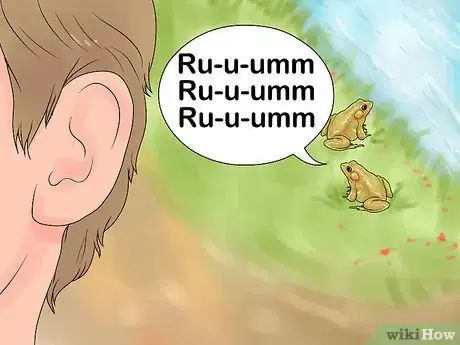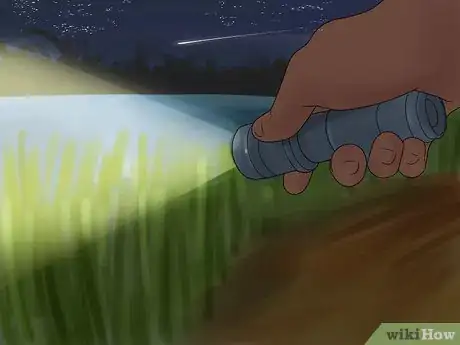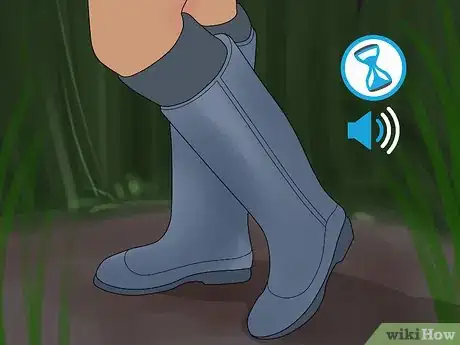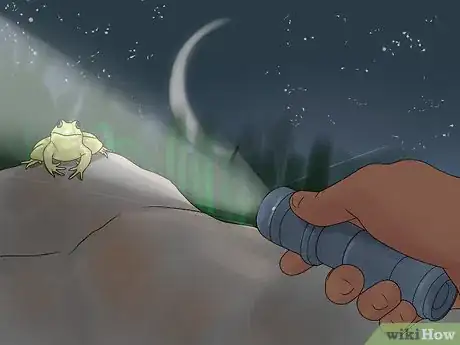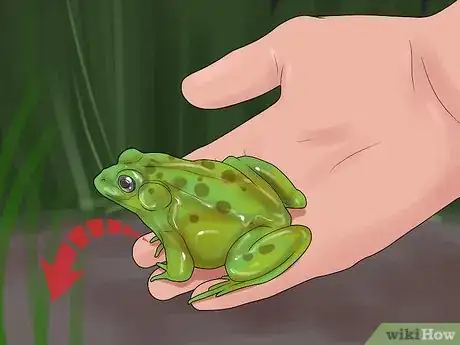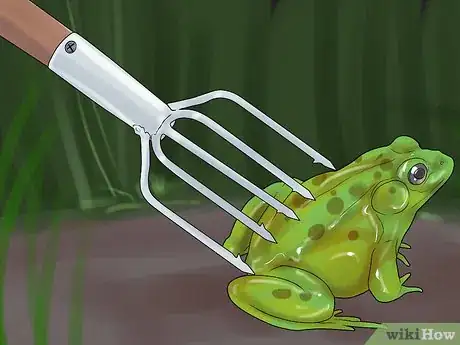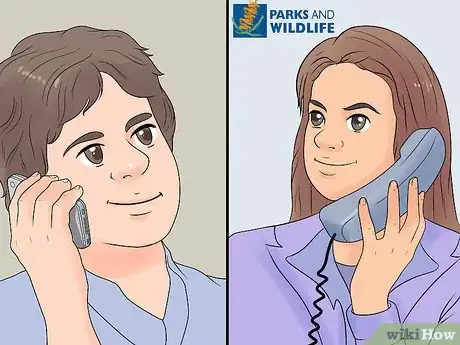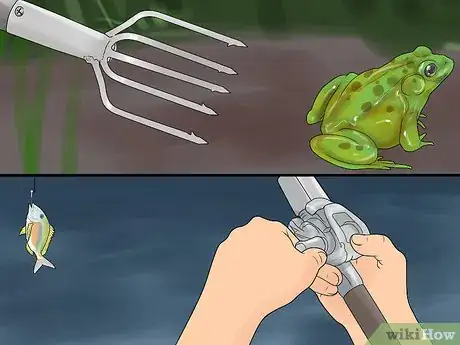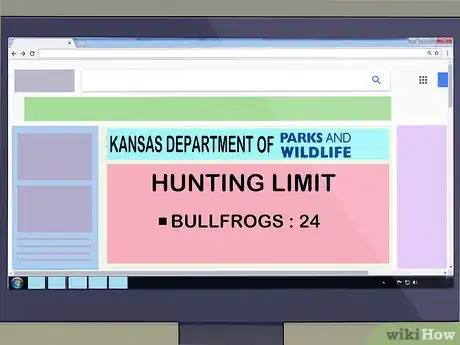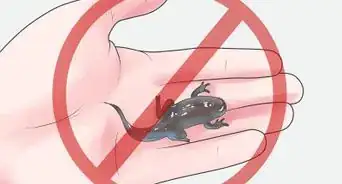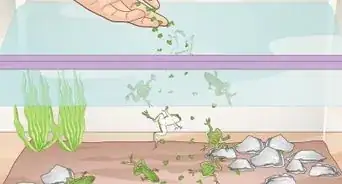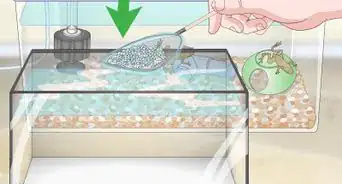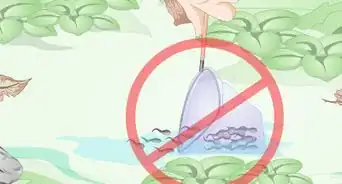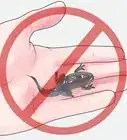This article was co-authored by Deanne Pawlisch, CVT, MA. Deanne Pawlisch is a Certified Veterinary Technician, who does corporate training for veterinary practices and has taught at the NAVTA-approved Veterinary Assistant Program at the Harper College in Illinois and in 2011 was elected to the board of the Veterinary Emergency and Critical Care Foundation. Deanne has been a Board Member of the Veterinary Emergency and Critical Care Foundation in San Antonio, Texas since 2011. She holds a BS in Anthropology from Loyola University and an MA in Anthropology from Northern Illinois University.
This article has been viewed 142,181 times.
Bullfrogs make a deep, rumbling song in the spring and summer. At night, you’ll see their bright eyes looking back at you from the shoreline. If you are excited to catch bullfrogs, you should check with state authorities to find out when the season is scheduled and what places you can go hunting in your region. As long as you have a license and a few simple tools, catching bullfrogs can be an enjoyable summer activity. Remember to respect any bullfrogs you catch and to release the small ones!
Steps
Catching Bullfrogs
-
1Choose your tools. This will depend on what your goals are. If you are planning to just catch frogs for fun, you may want different tools than if you're planning to eat frog legs for dinner. Bullfrogs can be caught bare-handed, but your hands should be clean and wet. Bullfrogs absorb things through their skin, so dirty hands could harm the frog. Alternatively, you may want to consider other tools, such as a frog gig. A frog gig is especially good for catching larger bullfrogs. If you don’t have a frog gig, a fishing net is also a good option. You’ll also need a flashlight and something to hold the bullfrogs, like a bucket.[1]
- If you are catching frogs to keep in an aquarium, you may want to use a net or your hands.
- A fishing net with a longer pole works best!
- The brighter the flashlight, the better!
- If you use a fishing pole, a fly fishing lure without a barb is a good choice.
- If you're transporting the frog, consider bringing a large plastic bucket with a lid.
-
2Find a good bullfrog habitat. Bullfrogs dwell in freshwater lakes, ponds, rivers, and streams. They tend to live where there is a tree canopy, cattails, and little to no current. Make sure you are hunting on public land during bullfrog season.[2]
- Never hunt for bullfrogs in a conservation area.
- Don’t hunt on private property, unless it is your own.
Advertisement -
3Listen for the chorus of bullfrog calls. Bullfrogs make a distinctive low-toned bass-like call, which sounds like a low "Ru-u-umm - Ru-u-umm." From early spring until summer, the male bullfrogs will sing together in a deep, roaring tone. Follow this sound to catch them.[3]
-
4Go hunting at night. Wait until the moon comes out to go frogging. Since it is easier to see the bullfrogs at night, you’ll want to wait till it is really dark outside.[4]
-
5
-
6Move slowly and quietly. If you are walking, take gentle steps. If you are in a canoe, don’t let your paddle hit the side of the canoe. Stop and pause occasionally, since you are likely to spot frogs more easily if you search for movement on the banks or in the river or bog.[7]
-
7Shine the light in their eyes to “jack” the bullfrog. As soon as you get to around 10 or 15 yards away, direct the LED light right into their eyes. This method is called “Jacking.” The bullfrog will go into a trance, like a deer in your car headlights. Use this opportunity to catch the bullfrog with your hands, frog gig or other instrument.[8]
- “Jacking" a bullfrog means using a strong flashlight directed at the frog's eyes at night.
-
8Pounce quickly and use a firm grip. Since bullfrogs are quick to respond to movement, you’ll need to pounce quickly and use a firm grip. They can easily slip out of your hands, so grab them firmly around the upper thighs. You will probably only get one chance.[9]
- Hold the bullfrog by grasping around the upper thighs with its legs together. This position minimizes chance of injury, while making it difficult for the critter to get away.
-
9Put the bullfrog in a closed container. Take the bullfrog off the gig, if you used one, and put it in the sack or container. Close the lid. If it is a burlap sack, pull the drawstring to close the bag. Unless you close the container or bag, the bullfrog will hop away![10]
-
10Let the little bullfrogs go. If you are catching bullfrogs to eat, you should let the little frogs go! Use your hands to catch the the little ones and then put them back in the water.[11]
-
11Use a five-pronged frog gig for the large bullfrogs. If you see a larger size bullfrog with eyes set wide apart, you’ll need a bigger tool! Don’t bother with the regular sized, 2-inch frog gig. Rather, pick the five-pronged frog gig to ensnare the larger bullfrogs.[12]
Meeting Bullfrog Hunting and Fishing Regulations
-
1Find out the bullfrog season in your region (if applicable). You’ll need to find out the local bullfrog season for your region. Although a few places, like Texas and Florida or locations where bullfrogs are considered an invasive species, allow bullfrog hunting all year, most places have a few summer months designated for bullfrog hunting. Your local tackle store should be able to give you the dates for bullfrog season but, if they can’t tell you, you can always contact your local department of parks and wildlife.[13]
- For instance, the bullfrog season in Kansas goes from July 1st to October 1st.[14]
-
2Decide whether you are going bullfrog hunting or fishing. Since the type of license you require to catch bullfrogs often depends on how you will catch them, you’ll need to make this decision before getting your license. Once you have an idea of what kind of fishing or hunting instrument you want to use, such as a frog gig, you should contact your department of fish and wildlife to find out if it is legal and what type of license is required.[15]
- A traditional and challenging way of catching bullfrogs is by hand, which is a lot of fun!
- Many people prefer to use a six or eight-foot pole with barbed tines, which is called a frog gig. People also use fishing lines, dip nets, bows, and rifles.
- If you are using a fishing net, you may need a fishing license.
-
3Get a fishing or a hunting license. Call your department of parks and wildlife to find out what license you need. If you are using fishing methods to catch bullfrogs, you’ll need a fishing license. However, if you are shooting bullfrogs, you’ll obviously need a hunting license. Pay for the license that is required for your region and the instrument you want to use.[16]
-
4Stay within the fishing or hunting limit. Your region will have a limit on the number of bullfrogs you can catch during bullfrog season, which is typically set by the department of parks and wildlife. Give them a ring or look on the website to find out the limit for your region. It is important to stay within this limit, which will help to ensure the integrity of local ecosystems and allow you to come back and catch more frogs next season![17]
- For instance, Kansas has a limit of 24 bullfrogs.
Warnings
- Don't wear any sunscreen or bug spray on your hands. Not only will it make your hands slippery, it will harm the frogs because they will absorb the chemicals through their skin.⧼thumbs_response⧽
- Beware of venomous snakes!⧼thumbs_response⧽
- Make sure that what you are catching is in fact a bullfrog, and not some endangered frog that resides in your state!⧼thumbs_response⧽
- Respect property rights and posted areas while out in your hunts.⧼thumbs_response⧽
- Avoid small bodies of stagnant water, which may have lots of dangerous bacteria.⧼thumbs_response⧽
- Be aware of any endangered or dangerous animals in your state.⧼thumbs_response⧽
- Frogs have small teeth that can hurt sensitive skin.⧼thumbs_response⧽
- Be careful of sharp rocks or hidden dangers such as tree limbs, glass or metal.⧼thumbs_response⧽
- If your region has crocodiles or alligators, exercise extreme caution when frog hunting![18]⧼thumbs_response⧽
Things You’ll Need
- Old laundry sack
- Boots
- LED flashlight
References
- ↑ http://www.fieldandstream.com/6-expert-tips-for-catching-bullfrogs#page-2
- ↑ http://goneoutdoors.com/catch-bull-frog-8672938.html
- ↑ http://www.fieldandstream.com/6-expert-tips-for-catching-bullfrogs
- ↑ https://1source.basspro.com/index.php/component/k2/237-fishing-info/1126-frog-gigging-hunting-bullfrogs-during-summer
- ↑ https://1source.basspro.com/index.php/component/k2/237-fishing-info/1126-frog-gigging-hunting-bullfrogs-during-summer
- ↑ http://www.fieldandstream.com/6-expert-tips-for-catching-bullfrogs
- ↑ http://www.fieldandstream.com/6-expert-tips-for-catching-bullfrogs
- ↑ https://1source.basspro.com/index.php/component/k2/237-fishing-info/1126-frog-gigging-hunting-bullfrogs-during-summer
- ↑ https://1source.basspro.com/index.php/component/k2/237-fishing-info/1126-frog-gigging-hunting-bullfrogs-during-summer
- ↑ http://goneoutdoors.com/catch-bull-frog-8672938.html
- ↑ http://www.fieldandstream.com/6-expert-tips-for-catching-bullfrogs#page-2
- ↑ http://www.fieldandstream.com/6-expert-tips-for-catching-bullfrogs#page-2
- ↑ http://goneoutdoors.com/catch-bull-frog-8672938.html
- ↑ http://ksoutdoors.com/Fishing/Fishing-Regulations/Bullfrogs
- ↑ http://goneoutdoors.com/catch-bull-frog-8672938.html
- ↑ http://goneoutdoors.com/catch-bull-frog-8672938.html
- ↑ http://ksoutdoors.com/Fishing/Fishing-Regulations/Bullfrogs
- ↑ https://1source.basspro.com/index.php/component/k2/237-fishing-info/1126-frog-gigging-hunting-bullfrogs-during-summer
About This Article
Before you try to catch a bullfrog, make sure your hands are clean and wet, since dirt from your hands can be absorbed by the bullfrog’s skin and harm it. Then, head out when it’s dark to a freshwater pond, river, or stream, and listen for the low-toned chorus that bullfrogs make. When you hear it, follow the sound, then shine a bright flashlight along the shoreline and look for bullfrog eyes. As soon as you see a pair, shine your flashlight right at them, which will “jack” or stun the bullfrog, giving you a chance to grab it quickly and firmly. For tips from our Veterinary reviewer on how to get a fishing or hunting license to catch bullfrogs, read on!


